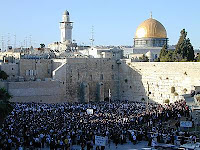Tuesday, October 28, 2008
Constructed to God’s precise specifications, the Tabernacle consisted of three main divisions -- Holy of Holies, the Holy Place and the Outer Court. Entering the courtyard through only one gate, the head of the family offered an animal sacrifice to atone for the sins of him and his family. Then the priest would make atonement and intercession for them inside the tent.
After washing his hands and feet at the basin, the High Priest would enter the Holy Place twice daily. There he would go before the Altar of Incense to offer prayers of atonement for those who had brought their sacrifices.
It was only the High Priest who could enter the Holy of Holies. Once a year he would move beyond the veil that separated sinful man from God to offer sacrifices for the nation of Israel. The only way to God was through the priest.
Jesus’ death changed forever the Old Covenant. When Jesus died on the cross, the veil that divided the Holy Place from the Holy of Holies in the Jerusalem Temple was split from top to bottom.
“And when Jesus had cried out again in a loud voice, he gave up his spirit. At that moment the curtain of the temple was torn in two from top to bottom.” Matthew 27: 50-51a
Jesus’ death meant that the boundaries to God had been removed. Jesus was the ultimate sacrifice and through his blood we all have redemption. We no longer rely on a High Priest to approach God each year. We can go boldly before God with our repentance, our petitions, and our praise as often as we choose.
After touring the Wilderness Tabernacle, I am even more in awe of God. He gave instructions for every detail of the temple. Every component of it was designed to symbolize God’s relationship with his people. He designed a clear path to approach him. Then he provided the ultimate symbol of God's relationship to his people - his son. God’s divine plan was accomplished when Jesus died to atone our sins forever. He ended the Old Covenant and began the New Covenant.
And so, dear brothers and sisters, we can boldly enter heaven’s Most Holy Place because of the blood of Jesus. By his death, Jesus opened a new and life-giving way through the curtain into the Most Holy Place. And since we have a great High Priest who rules over God’s house, let us go right into the presence of God with sincere hearts fully trusting him. For our guilty consciences have been sprinkled with Christ’s blood to make us clean, and our bodies have been washed with pure water. Hebrews 10: 12-21
Dear God, thank you for sending your son to atone for my sins and redeem me. Amen.








